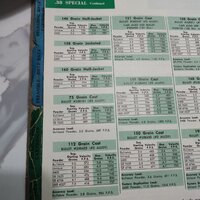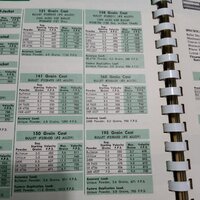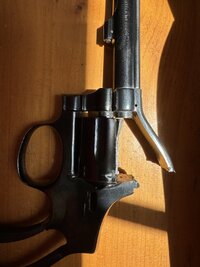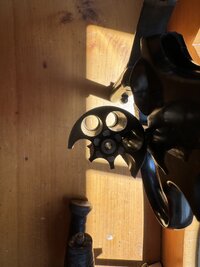.38 Special PSI is around 17,000 for regular loads and 20,000 for +P loads in modern handguns. I have searched the net and cannot find what is the PSI that they use for proof loads for .38 Special. I have checked the SAAMI website and they don't specifically list the data. Thanks in advance for any help, I don't need a link just a number and it source.
-
If you enjoy the forum please consider supporting it by signing up for a NES Membership The benefits pay for the membership many times over.
-
Be sure to enter the NES/MFS May Giveaway ***Canik METE SFX***
You are using an out of date browser. It may not display this or other websites correctly.
You should upgrade or use an alternative browser.
You should upgrade or use an alternative browser.
What is the PSI for a .38 Special Proof Load?
- Thread starter Agincourt
- Start date
Some reloading sites will list whatever pressure they hit with powder/ bullet combo X.
Are you looking for the max pressure before the cylinder splits?
Standard loads would probably be proof enough, 160 gr heads seem to produce the highest pressure if you reload. Looking at a Lyman cast book, it probably measured through a test barrel.
If you need a max pressure/ proof then I can tell you a double charge of bullseye and a 160 coated lead head will split the case. Probably well over 21000 psi.
Are you looking for the max pressure before the cylinder splits?
Standard loads would probably be proof enough, 160 gr heads seem to produce the highest pressure if you reload. Looking at a Lyman cast book, it probably measured through a test barrel.
If you need a max pressure/ proof then I can tell you a double charge of bullseye and a 160 coated lead head will split the case. Probably well over 21000 psi.
Last edited:
Yes and then the max pressure at which you can estimate or know that the cylinder will split. I have a K-38 Masterpiece that someone blew up with a handload, the chamber involved and the one on either side were destroyed and the top strap split upwards aft. I am wondering what level beyond 20000 PSI would cause that to happen.Some reloading sites will list whatever pressure they hit with powder/ bullet combo X.
Are you looking for the max pressure before the cylinder splits?
This is similar to what can happen with a Webley that has been 'shaved' to accept .45 ACP rounds. I have seen figures that the operating pressure for the .455 Webleys to be in the 12700 to 13200 psi range the latter specifically cited for the Mark VI, which along with the Mark V, was the only one designed for smokeless powder. The .45 ACP is stated to have a standard operating pressure of between 19000 to 21000 psi depending on the source cited. There are pictures on the 'net of .455 Webley cylinders which failed with .45 ACP rounds. So it seems that something in the range of six to seven thousand PSI beyond the standard operating pressure is enough to blow the cylinder. (I have also read, can't find the source now, that the .45 ACP round pressure is higher than the proof load pressure for the Webleys).
I just saw the first line of your reply when I posted the above I have just read the rest of your reply thanks.Yes and then the max pressure at which you can estimate or know that the cylinder will split. I have a K-38 Masterpiece that someone blew up with a handload, the chamber involved and the one on either side were destroyed and the top strap split upwards aft. I am wondering what level beyond 20000 PSI would cause that to happen.
This is similar to what can happen with a Webley that has been 'shaved' to accept .45 ACP rounds. I have seen figures that the operating pressure for the .455 Webleys to be in the 12700 to 13200 psi range the latter specifically cited for the Mark VI, which along with the Mark V, was the only one designed for smokeless powder. The .45 ACP is stated to have a standard operating pressure of between 19000 to 21000 psi depending on the source cited. There are pictures on the 'net of .455 Webley cylinders which failed with .45 ACP rounds. So it seems that something in the range of six to seven thousand PSI beyond the standard operating pressure is enough to blow the cylinder. (I have also read, can't find the source now, that the .45 ACP round pressure is higher than the proof load pressure for the Webleys).
Ah, gotcha.
So considerin the age of the revolver in question, what ammo in .38 spl (I'm guessing police issue) was available around the 60's or whenever it was manufactured?
Were there +p loads available back then?
Looking through some load data, and considering it was a K frame and how old it is, it was probably rated for 18-19,000 psi max.
Just a guestimation
So considerin the age of the revolver in question, what ammo in .38 spl (I'm guessing police issue) was available around the 60's or whenever it was manufactured?
Were there +p loads available back then?
Looking through some load data, and considering it was a K frame and how old it is, it was probably rated for 18-19,000 psi max.
Just a guestimation
Yes probably, the 'net says that the Plus+ loads are only for 'modern' revolvers which have better metallurgy.
I suspect but cannot prove that it was a handload where the operator got careless, maybe a 'double charge'? Well whatever it was I will set it up over my reloading bench with a sign "Pay Attention!".
I suspect but cannot prove that it was a handload where the operator got careless, maybe a 'double charge'? Well whatever it was I will set it up over my reloading bench with a sign "Pay Attention!".
You could try castboolits.com.
Theres probably someone over there that would have production date info on whats rated for what.
Just a forewarning though, after about 8 replies in everything turns to "Well my 30/30 runs like this" and "muh 45/70 only shoots this"
Probably a lot of wheezing going on as well.
I would definitely say a double charge, and probably a double charge of the wrong powder. I've split enough cases to know what it could do in a smaller frame.
The tough part with older handguns, is the powder available today vs. what was available in the 50's/60's/70's.
Like a max or near max charge or overcharge of Titegroup is going to react a lot more violently that a max charge of Herco or something from that age group.
You'd almost need a burn rate chart that lists powders from way back then and whats available now.
Theres probably someone over there that would have production date info on whats rated for what.
Just a forewarning though, after about 8 replies in everything turns to "Well my 30/30 runs like this" and "muh 45/70 only shoots this"
Probably a lot of wheezing going on as well.
I would definitely say a double charge, and probably a double charge of the wrong powder. I've split enough cases to know what it could do in a smaller frame.
The tough part with older handguns, is the powder available today vs. what was available in the 50's/60's/70's.
Like a max or near max charge or overcharge of Titegroup is going to react a lot more violently that a max charge of Herco or something from that age group.
You'd almost need a burn rate chart that lists powders from way back then and whats available now.
OK Trashcan Dan, boy howdy! and thanks. I posted over on CastBoolits and got a lot of info, never actually got the PSI for the .38 Special proof load but got detailed answers. If you go to What PSI for a .38 Special K-38 Would Blow Out the Cylinder and the Top Strap? you will find excellent answers, my name there is Crecy (which seems to be a good balance with Agincourt).
Briefly, it seems the best hypothesis is that the person who blew up the K-38 either didn't have enough of an air space or way too deep seating of the bullet. Outpost75 posted a chart that shows that a wadcutter with 5.something grains of Bullseye that is too deeply seated can generate more than 70,000 PSI! Hick posted info on his own evaluation leading him to conclude that it would take at least 35,000 PSI to blow the cylinder. I suspect that a 'normal' charge of powder with a too deeply seated bullet is what caused all this to happen.
Also, I just want to note that there is no bulge in the barrel and no evidence of a squib load, this appears to be one round that blew up and did all the damage.
Briefly, it seems the best hypothesis is that the person who blew up the K-38 either didn't have enough of an air space or way too deep seating of the bullet. Outpost75 posted a chart that shows that a wadcutter with 5.something grains of Bullseye that is too deeply seated can generate more than 70,000 PSI! Hick posted info on his own evaluation leading him to conclude that it would take at least 35,000 PSI to blow the cylinder. I suspect that a 'normal' charge of powder with a too deeply seated bullet is what caused all this to happen.
Also, I just want to note that there is no bulge in the barrel and no evidence of a squib load, this appears to be one round that blew up and did all the damage.
There it is
5 gr of Bullseye is pretty close to a double, depending on the gr weight of the head.
Countersunk, and its bad news.
That Outpost guy has been around there a while. I had an account back in 2008 or so and he gave me some pretty good info on .357 levergun twistrates and what to use for that Rossi slow twist.
5 gr of Bullseye is pretty close to a double, depending on the gr weight of the head.
Countersunk, and its bad news.
That Outpost guy has been around there a while. I had an account back in 2008 or so and he gave me some pretty good info on .357 levergun twistrates and what to use for that Rossi slow twist.
Just for the hell of it-
Shoot S&W an e-mail with you former wheel guns serial number and see if they can pull up any max pressure or how they proof test the cylinders
They may have different test numbers for different decades.
Shoot S&W an e-mail with you former wheel guns serial number and see if they can pull up any max pressure or how they proof test the cylinders
They may have different test numbers for different decades.
OK and thanks again. So right there it is approaching or at a double charge. I will see what S&W says. Take care.Just for the hell of it-
Shoot S&W an e-mail with you former wheel guns serial number and see if they can pull up any max pressure or how they proof test the cylinders
They may have different test numbers for different decades.
- Joined
- Jul 28, 2016
- Messages
- 512
- Likes
- 640
I think your guess of a massive over-pressure, like 70K PSI is very likely. From the fact that it broke the topstrap, as well as the cylinder, I was going to guess that the load was in excess of a 357 magnum load, which would be 35K PSI.
I would be interested to know the age of the revolver in question, since guns made after 1957, when the model numbers were added, are considered to be slightly stronger. But even older Smith revolvers are still pretty strong.
My guess of a very high pressure load is based on the history of the 38 special heavy duty, or 38-44 load. Before the 357 magnum was developed, Smith made 38 special revolvers using the larger 44 special frame that we would now call and N-frame. And heavy loads made just for these guns were called heavy duty or 38-44 loads. General estimates were that 38-44 rounds were loaded to about 28K PSI, and unlike 357 magnum, they would fit in any 38 special chamber.
It was strongly recommended not to put 38-44 loads in other revolvers, but of course people did try it, and the regular frame guns did not blow apart. The guns may have developed extra end shake, but they certainly did not break the topstrap as well as the cylinder.
So my guess is that to completely destroy the revolver, the round was well in excess of 28K PSI. And probably pretty far above that.
I would be interested to know the age of the revolver in question, since guns made after 1957, when the model numbers were added, are considered to be slightly stronger. But even older Smith revolvers are still pretty strong.
My guess of a very high pressure load is based on the history of the 38 special heavy duty, or 38-44 load. Before the 357 magnum was developed, Smith made 38 special revolvers using the larger 44 special frame that we would now call and N-frame. And heavy loads made just for these guns were called heavy duty or 38-44 loads. General estimates were that 38-44 rounds were loaded to about 28K PSI, and unlike 357 magnum, they would fit in any 38 special chamber.
It was strongly recommended not to put 38-44 loads in other revolvers, but of course people did try it, and the regular frame guns did not blow apart. The guns may have developed extra end shake, but they certainly did not break the topstrap as well as the cylinder.
So my guess is that to completely destroy the revolver, the round was well in excess of 28K PSI. And probably pretty far above that.
I have tried to date the revolver by serial number but the 'net is no help, it isn't like a Colt where you can find it right away. The only info I can add as to date of manufacture is the Serial Number 6K66XXX on the frame with the notation Mod. 14-3. According to several sources on the 'net the 14-3 was first made apparently sometime in the early sixties.I think your guess of a massive over-pressure, like 70K PSI is very likely. From the fact that it broke the topstrap, as well as the cylinder, I was going to guess that the load was in excess of a 357 magnum load, which would be 35K PSI.
I would be interested to know the age of the revolver in question, since guns made after 1957, when the model numbers were added, are considered to be slightly stronger. But even older Smith revolvers are still pretty strong.
My guess of a very high pressure load is based on the history of the 38 special heavy duty, or 38-44 load. Before the 357 magnum was developed, Smith made 38 special revolvers using the larger 44 special frame that we would now call and N-frame. And heavy loads made just for these guns were called heavy duty or 38-44 loads. General estimates were that 38-44 rounds were loaded to about 28K PSI, and unlike 357 magnum, they would fit in any 38 special chamber.
It was strongly recommended not to put 38-44 loads in other revolvers, but of course people did try it, and the regular frame guns did not blow apart. The guns may have developed extra end shake, but they certainly did not break the topstrap as well as the cylinder.
So my guess is that to completely destroy the revolver, the round was well in excess of 28K PSI. And probably pretty far above that.
I hadn't thought of a .38-44 load, even at 28000 PSI that might be enough to blow out a cylinder that had a weak spot, well that is my guesstimate.
- Joined
- Jul 28, 2016
- Messages
- 512
- Likes
- 640
According to the Standard Catalog of Smith & Wesson Second Edition, the 6K66XXX block of serial numbers were made in 1975. That is consistent with the era for the Model 14-3, which was made from 1967 to 1977.
S&W has stated that all model marked .38 special revolvers are OK for +P rounds. And personally, I do not hesitate to feed a 1970's era K-frame a steady diet of .38 +P if I have it available.
I have read discussions on the S&W forum of people who bored out the cylinders on these revolvers and tested them with .357 magnum. That is not a supported, recommended, or safe thing to do. But it has been tested to some extent, and the guns did survive a few rounds. It also would not be surprising if that same testing did destroy a revolver in some cases. But I would expect that destruction to involve bulging or destroying one chamber. I still believe that if the cylinder was completely broken apart, and the top-strap shattered as well, then the load probably greatly exceeded .357 pressure. However, I have not personally done any of this destructive testing, so I could be wrong.
S&W has stated that all model marked .38 special revolvers are OK for +P rounds. And personally, I do not hesitate to feed a 1970's era K-frame a steady diet of .38 +P if I have it available.
I have read discussions on the S&W forum of people who bored out the cylinders on these revolvers and tested them with .357 magnum. That is not a supported, recommended, or safe thing to do. But it has been tested to some extent, and the guns did survive a few rounds. It also would not be surprising if that same testing did destroy a revolver in some cases. But I would expect that destruction to involve bulging or destroying one chamber. I still believe that if the cylinder was completely broken apart, and the top-strap shattered as well, then the load probably greatly exceeded .357 pressure. However, I have not personally done any of this destructive testing, so I could be wrong.
Great and thanks. So it is a mid-seventies production. In the revolver I have what I assume to be the index chamber where the explosion occurred has the outer half completely blown off, as do each of the chambers on either side; the sides of the three chambers next to the hole for the ejector rod are fairly intact. I would think that the middle, index chamber was under the top strap when it blew up. I purchased this 'as is' and it did not include any of the scattered pieces of the three chambers involved, so I can't state any information on their condition.According to the Standard Catalog of Smith & Wesson Second Edition, the 6K66XXX block of serial numbers were made in 1975. That is consistent with the era for the Model 14-3, which was made from 1967 to 1977.
S&W has stated that all model marked .38 special revolvers are OK for +P rounds. And personally, I do not hesitate to feed a 1970's era K-frame a steady diet of .38 +P if I have it available.
I have read discussions on the S&W forum of people who bored out the cylinders on these revolvers and tested them with .357 magnum. That is not a supported, recommended, or safe thing to do. But it has been tested to some extent, and the guns did survive a few rounds. It also would not be surprising if that same testing did destroy a revolver in some cases. But I would expect that destruction to involve bulging or destroying one chamber. I still believe that if the cylinder was completely broken apart, and the top-strap shattered as well, then the load probably greatly exceeded .357 pressure. However, I have not personally done any of this destructive testing, so I could be wrong.
steven grammont
NES Member
No pics?
That don't publish the specs on proof loads..38 Special PSI is around 17,000 for regular loads and 20,000 for +P loads in modern handguns. I have searched the net and cannot find what is the PSI that they use for proof loads for .38 Special. I have checked the SAAMI website and they don't specifically list the data. Thanks in advance for any help, I don't need a link just a number and it source.
- Joined
- Jul 28, 2016
- Messages
- 512
- Likes
- 640
Here is an article about development of the cylinder for the Ruger Super Redhawk 454 Casull. This is the only article that I ever remember reading that talks specifically about proof loads. The article is does appear to be partly marketing material for a steel manufacturer, but I believe the details are still accurate.

 www.carpentertechnology.com
www.carpentertechnology.com
And here is a brief relevant quote from the article.

World's most Powerful Revolvers gets lift from Aerospace Alloys
Custom 465 stainless steel, developed as a candidate for aerospace components, is a premium-melted, martensitic, age-hardenable alloy. Learn more!
And here is a brief relevant quote from the article.
That compares with approximately 62,000 psi pressure generated when firing a .454 Casull revolver.
...
Ruger made a cylinder from Custom 465 stainless, then fired 50 proof rounds from each of six chambers (total 300 rounds) at 92,000 psi.
KMM696
NES Member
Per SAAMI-Z299.3-2022-Centerfire-Pistol-Revolver-Approved-12-13-2022, page 168 the acceptable proof load for 38 Special +P (as the plain 38 Special proof was discontinued after +P was developed) is between 27k and 29.5k psi..38 Special PSI is around 17,000 for regular loads and 20,000 for +P loads in modern handguns. I have searched the net and cannot find what is the PSI that they use for proof loads for .38 Special. I have checked the SAAMI website and they don't specifically list the data. Thanks in advance for any help, I don't need a link just a number and it source.
SAAMI's discussion of proof load methodology is from p.163 to the end.
Last edited:
Share:




